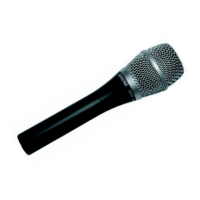©2009, Shure Incorporated
CARDIOID CONDENSER MICROPHONE
The Shure SM86 is a unidirectional (cardioid) condenser vocal
microphone for professional use in live performance. An extremely
rugged microphone, the SM86 withstands the rigors of touring
while delivering studio-quality sound. The tailored frequency
response of the SM86 reproduces vocals with clarity. A cardioid
pickup pattern isolates the main sound source while minimizing
unwanted background noise. The built-in three-point shock mount
minimizes handling noise, and a two-stage pop fi lter reduces
wind and breath “pop” noise. The SM86 is an excellent selection
For use with both stage monitors and personal in-ear monitors.
Condenser cartridge for studio quality sound
Tailored frequency response for a clear reproduction of
Rugged construction withstands the rigors of touring
Cardioid polar pattern minimizes unwanted background
Excellent choice for stage monitors and personal in-ear
Built-in three-point shock mount minimizes handling noise
Two-stage “pop” fi lter reduces wind and breath noise
Unidirectional microphones, like the SM86, progressively boost
bass frequencies up to 15 dB as the microphone gets closer to
the sound source. This phenomenon, known as proximity effect,
can be used to create a warmer, more powerful sound. To prevent
excessive or “boomy” low frequency sound during close-up use,
the SM86 bass response gradually rolls off. This provides greater
control and helps the user take advantage of proximity effect.
APPLICATIONS AND PLACEMENT
The SM86 is ideal for close-up vocals and can be held in the hand
or mounted on a stand. Some of the most common applications
and placement techniques are listed in the following table. Keep
in mind that microphone technique is largely a matter of personal
taste—there is no one “correct” microphone position.
Lips less than 15 cm (6 in.) away or
touching the windscreen, on axis to
bass, maximum isolation from
15 to 60 cm (6 in. to 2 ft.) away from
mouth, just above nose Height.
More than 60 cm (2 ft.) away.
Thinner, more distant sound;
noticeable levels of ambient
STAGE MONITOR & P.A. LOUDSPEAKERS
Place the stage monitor directly behind the microphone (see
Figure 1). Locate the P.A. loudspeakers so that they point
away from the rear of the microphone. With the speakers lo-
cated in these positions, the possibility of feedback is greatly
reduced. Always check the stage setup before a performance
to ensure optimum placement of microphone and monitors.
CARDIOID MICROPHONE POSITIONING
GENERAL RULES FOR MICROPHONE USE
Aim the microphone toward the desired sound source
and away from unwanted sources.
Locate the microphone as close as practical to the desired
Work close to the microphone for extra bass response.
Use only one microphone per sound source.
Locate microphones at least three times as far from other
microphones as from the sound source.
Use as few microphones as practical.
Place microphones far from sound-refl ecting surfaces.
Add a windscreen when using the microphone outdoors.
Avoid excessive handling to minimize mechanical noise.

